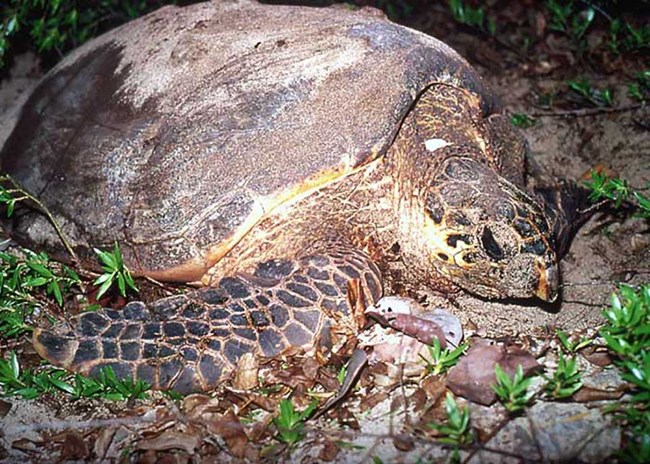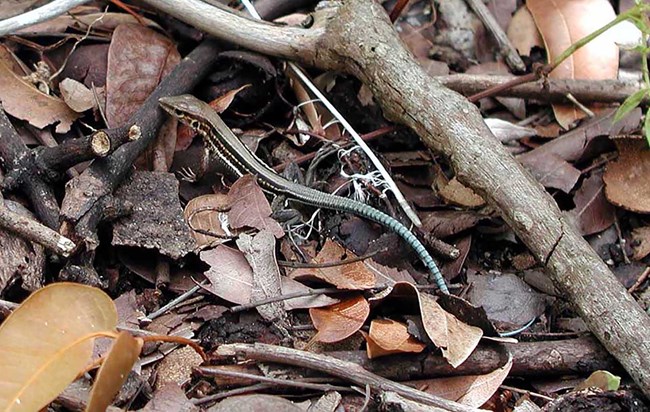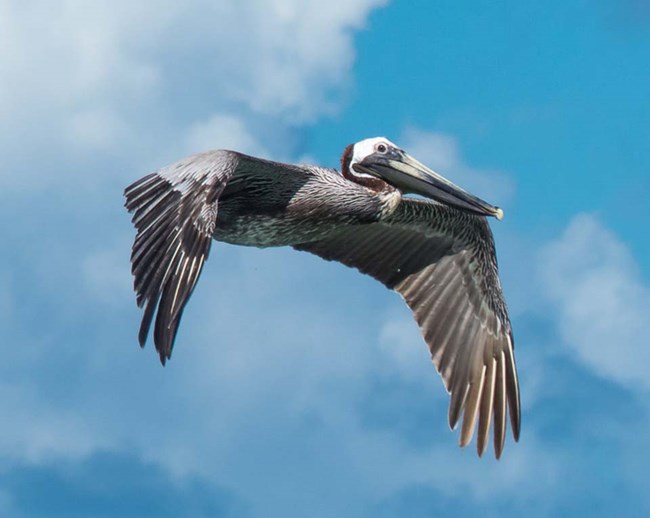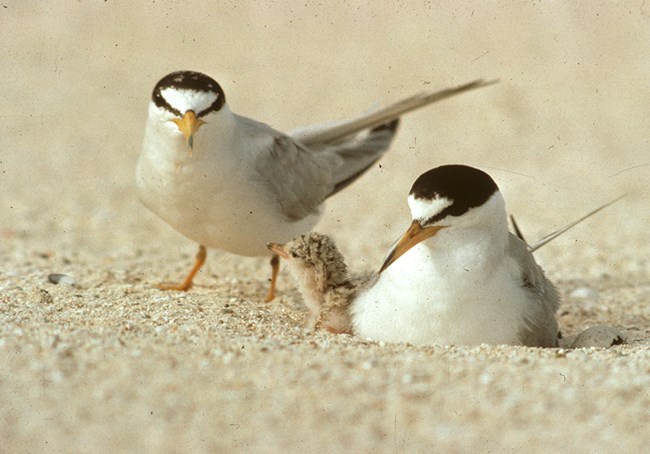
NPS photo Sea Turtles The Virgin Islands provide critical nesting, foraging, and developmental habitat for three species of sea turtle, the leatherback (Dermochelys coriacae) and hawksbill turtle (Eretmochelys imbricata) both endangered species, and the green turtle (Chelonia mydas), a threatened species. Loggerhead turtles (Caretta caretta) are transitory and only occasionally seen in the islands. The Leatherback Sea Turtle (Dermochelys coriacea) Sandy Point National Wildlife Refuge, on the western end of St. Croix, is the main nesting beach for leatherback turtles in the Northern Caribbean. Tagging studies have shown movement by females between regional nesting beaches in Puerto Rico, Anguilla, and St. Croix. This long-term tagging program provides essential information on leatherback turtle population trends available nowhere else in U.S. properties. Since 1981, 342 leatherback turtles have been tagged, with anywhere from 18 - 55 females nesting each year. Prior to protection efforts, it is possible that 100 percent of the nests laid at Sandy Point were either poached or lost to beach erosion (seasonally 50 to 60 percent). The research program at Sandy Point protects the beach, and nests threatened by erosion are relocated, reducing the loss of nests to less than five percent every year. It is possible to speculate that the increase in numbers of females nesting per season, given an average age to maturity for leatherbacks of 10 to 15 years, is a direct result of beach protection and nest relocation. The Green Sea Turtle (Chelonia mydas) Observations of green turtle nesting populations have been collected incidentally by both leatherback and hawksbill turtle research programs in the Virgin Islands since 1980s. In 1993 and 1994, daytime beach surveys were conducted for green and hawksbill turtles on St. Croix. The Virgin Islands have never been an important place for green turtle nesting, but is an important foraging ground for juvenile turtles. The number of green turtle nesting activities remains low for all the islands, but since the 1970s there seems to be gradual increase in numbers of juveniles observed in the foraging grounds. The only island that still supports any amount of green turtle nesting is St. Croix, with an average of 100 nests per year (1980 - 1990). The largest concentration of green turtle nesting activities occurs on St. Croix's east end beaches averaging 15 nests per year. Buck Island Reef supports between 1 to 3 green turtles per season, with between 8 and 10 nests per year. The Hawksbill Sea Turtle (Eretmochelys imbricata) There are very few places in the Caribbean where any large numbers of hawksbill turtles remain. In the Virgin Islands, hawksbill nesting occurs on St. Croix (Buck Island Reef, and the beaches on the eastern end of St. Croix), and on a few isolated beaches on St. John, St. Thomas (mostly on the offshore cays). The most important concentrations of hawksbill turtle nesting activities remaining in the Virgin Islands occurs at Buck Island Reef National Monument and the beaches on the eastern end of St. Croix (Jack's/Isaac's/East End Bays). Buck Island and St. Croix's east end beaches are supporting two remnant populations of 20 - 40 nesting hawksbill turtles per season. Since 1988, 200 individual hawksbill turtles have been tagged nesting on Buck Island Reef National Monument. Hawksbill turtles return to nest every 2 to 4 years, indicating high degree of nesting beach fidelity. Of these remigrants, between 50 to 80 percent have returned to nest in subsequent years representative of the high survivorship of adult sea turtles. Prior to 1996 annual recruitment of first time nesters at BUIS was less than 15%; in 1996 and 1997, the number of recruits increased to 50% of the nesting population. In 1994 a saturation-tagging program was initiated on St. Croix's east end beaches, where 14 hawksbill turtle were tagged. In 1996 & 1997, the first intraseasonal movements of two hawksbill females were recorded. A Buck Island nesting female nested in Jack’s Bay and a East End tagged hawksbill female nested on BUIS twice. Throughout their range, hawksbill turtles nest in low density, normally between a few dozen and, at most, a few hundred individuals. The smallest of the three species of sea turtle nesting in the Virgin Islands, hawksbill turtles are the most seriously endangered throughout their range. They are omnivorous, living and feeding in coral reefs and mangroves. They are best known for their beautiful shell, “tortoise-shell”, which has been prized for jewelry throughout the world -- also the cause of their present endangered status. 
NPS photo Lizards Buck Island provides very important habitat for two endemic lizards, the St. Croix anole and the cotton ginner dwarf gecko. Since the island-wide rat and mongoose eradications, Buck Island now also provides a suitable environment for the reintroduction of the endangered St. Croix ground lizard (Ameiva polops) which probably existed on Buck Island prior to the introduction of the mongoose around 1912. 
Photo by Rick Starr. Birds For the Virgin Islands, and Buck Island, there are 210 known species of birds, including fossil remains of extinct species, permanent residents, breed and leave, non-breeding migrant and visiting species, and introduced breeders. Of these, sixty are native breeding species, 129 are non-breeding migrants, ten are “breed and leave,” six are introduced and probable breeders, and 5 are introduced as possible breeders. Buck Island is one of few places in the Virgin Islands where endangered brown pelicans and threatened least terns nest. Pelicans nest from June through March. Other birds commonly seen include Bahama ducks, bananaquits, gray kingbirds, greenthroated hummingbirds, kestrels, magnificent frigate birds, ospreys, pearlyeyed thrashers, and zenaida doves. 
NPS photo (Solvin Zankl) |
Last updated: April 6, 2018
